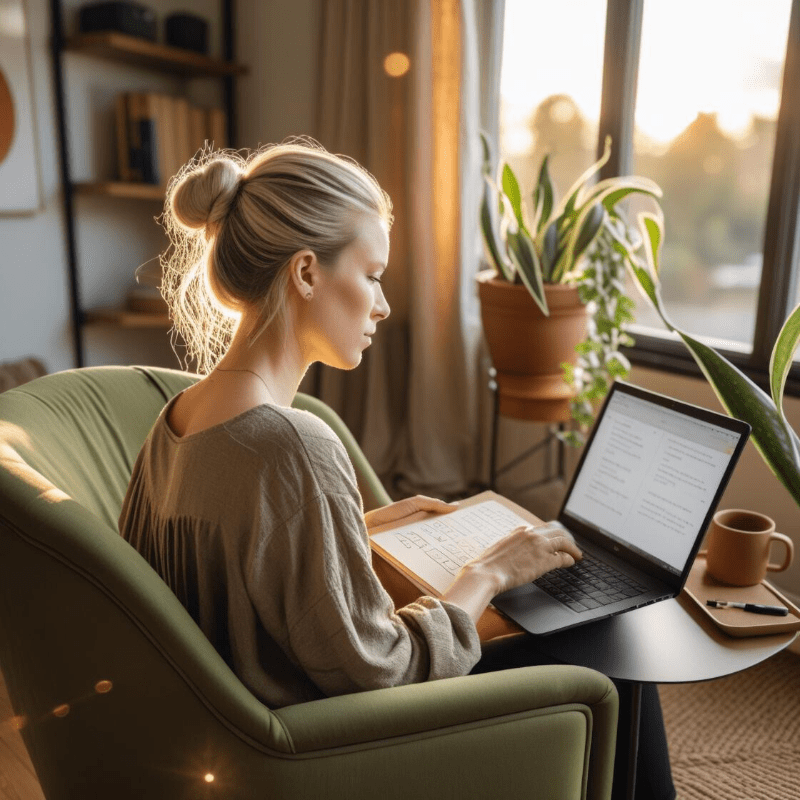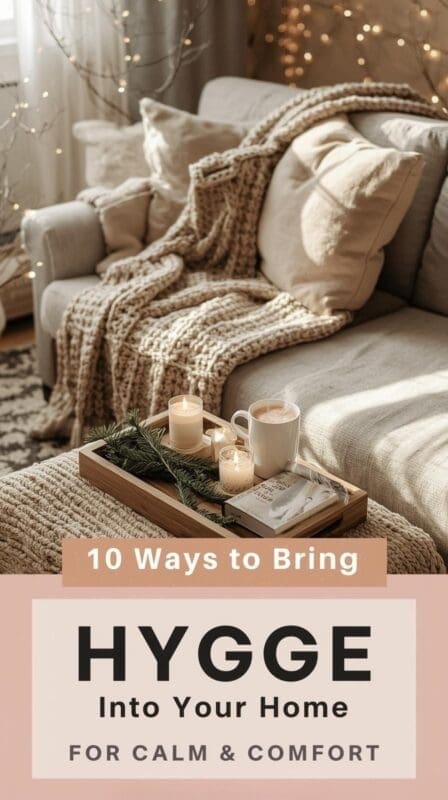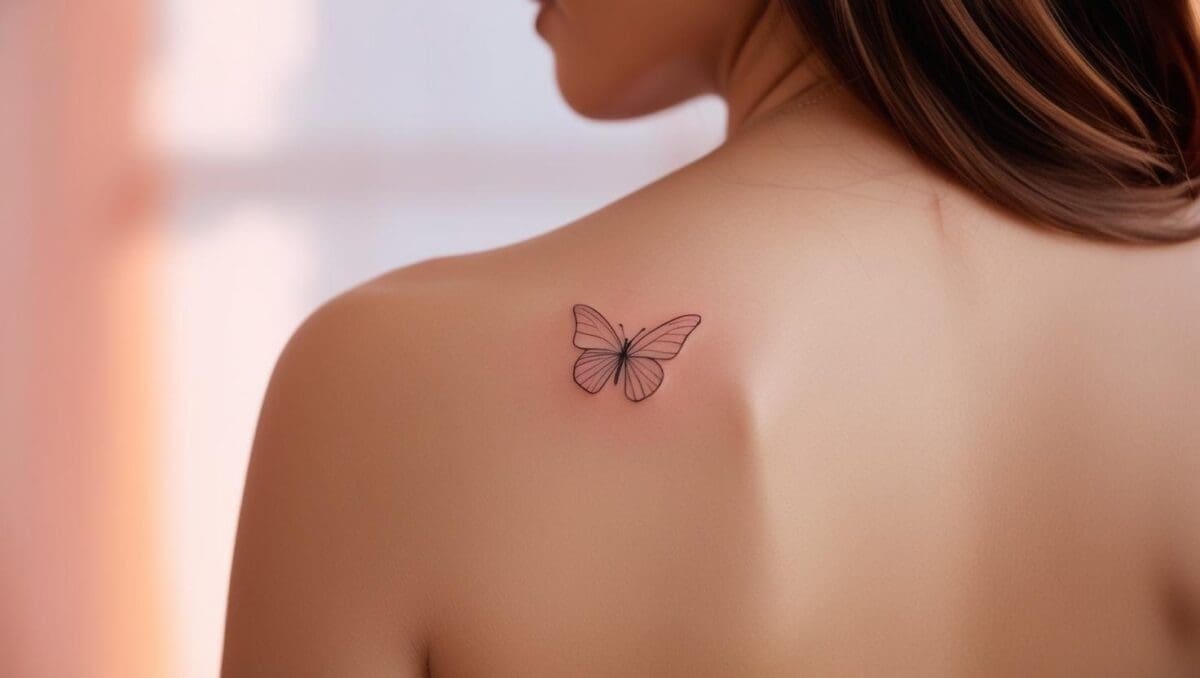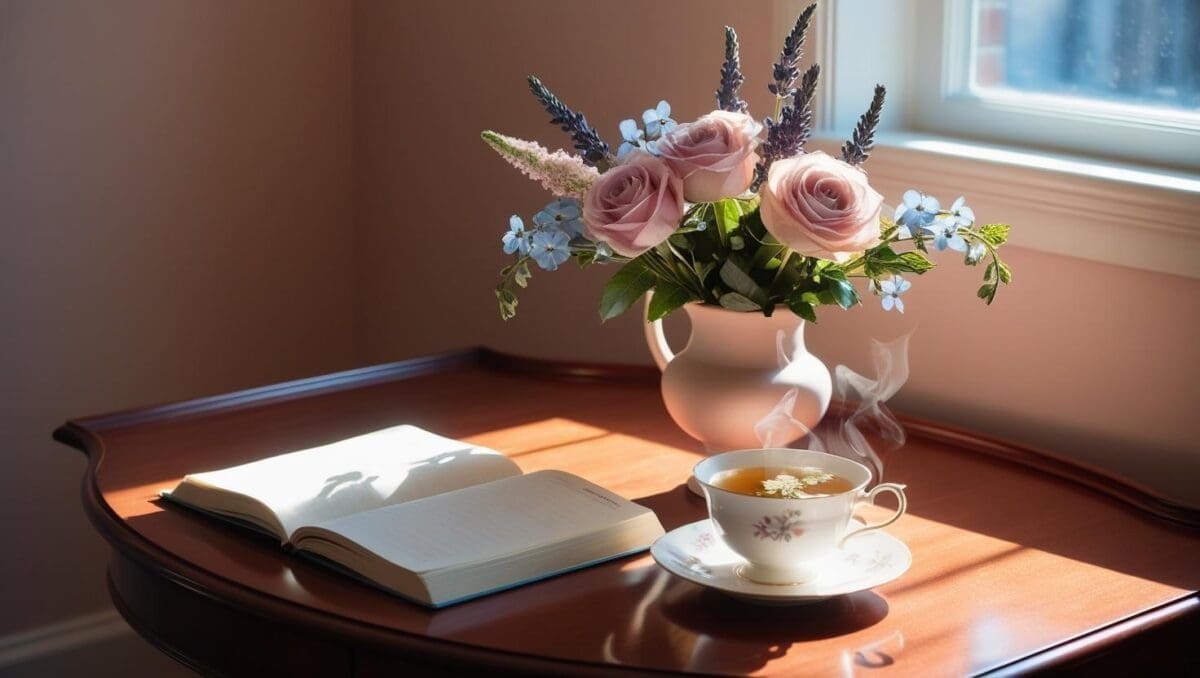There’s a quiet comfort that winter brings — a softness that asks you to pause, light a candle, and find warmth not just in your space, but in your state of mind.
That’s the essence of hygge (pronounced “hoo-gah”) — a Danish concept that celebrates coziness, connection, and presence.
It’s not about decorating perfectly.
It’s about designing your environment so your nervous system feels safe, soothed, and grounded.
If winter tends to stir anxiety or low mood, hygge-inspired mindful décor can become a simple, sensory way to restore calm — one warm light, soft blanket, and deep breath at a time.
How Hygge Supports Anxiety, Low Mood & Mental Health
When you live with anxiety or chronic stress, your body is often on high alert — scanning for threats, waiting for the next demand.
Hygge interrupts that loop.
It replaces the body’s “fight or flight” signals with sensory experiences of safety: warmth, softness, gentle light, and comforting predictability.
Each element sends a message to your nervous system —
“You’re safe here. You can exhale.”
And once your body believes it’s safe, your mind can finally begin to rest.
🧠 The Science of Hygge and Emotional Regulation
From a therapeutic perspective, hygge naturally aligns with polyvagal theory, which describes how our nervous system shifts between stress and calm.
- Warm light and soft textures activate the ventral vagal state — our calm, social engagement mode.
- Predictable sensory rituals (like lighting a candle every evening) reinforce safety through repetition.
- Scent, warmth, and sound engage the parasympathetic system, lowering cortisol and steadying breath.
In Scandinavia, where winters are long and dark, hygge evolved as a mental-health strategy — a cultural form of seasonal regulation that keeps isolation from becoming despair.
Hygge is nervous-system therapy disguised as interior design.
🌿 How Cozy Environments Heal the Mind
Your senses — sight, touch, scent, hearing — are direct gateways to the emotional brain.
When you soften these inputs through light, texture, and gentle rhythm, your body releases serotonin and oxytocin, the hormones of comfort and connection.
Small acts — wrapping yourself in a blanket, lighting a candle, holding a warm mug — may seem ordinary, but they’re micro-interventions for stress.
Each one teaches your brain that stillness is safe.
This is the beginning of healing for anxiety and mood disorders: when the body learns that calm isn’t dangerous — it’s restorative.
☕ Incorporating Hygge Into Daily Life
True hygge doesn’t require a remodel or expensive décor — it’s about intentional sensory consistency.
1. Soft Start Mornings
- Light a candle before sunrise.
- Sip something warm while noticing its scent.
- Take three slow breaths before checking messages.
🧠 Reduces morning cortisol spikes and anxiety surges.
2. Micro-Moments of Comfort
- Keep a soft shawl on your chair.
- Play gentle instrumental music during tasks.
- Step outside for natural light between calls.
🧠 Prevents stress buildup through micro-regulation.
3. The Hygge Pause
Dedicate ten minutes daily to simply be — a tea, a window view, silence.
Think of it as clearing your emotional browser tabs.
4. Evening Decompression
- Dim lights an hour before bed.
- Take a warm shower or bath with calming scents.
- Journal one gratitude before sleep.
🧠 Consistent cues retrain your brain’s sleep and safety cycles.
🕯 1. Soften the Light — Create a Gentle Glow
Harsh overhead bulbs keep the body in alert mode.
Replace them with warm, layered light: cordless table lamps, LED candles, or salt lamps.
💬 Keep lights low after sunset — it mirrors nature’s rhythm and signals rest.
🧠 Soft light increases melatonin and helps anxious bodies unwind.
🪞 2. Choose Colors That Ground You
Swap cold whites for muted earth tones:
- Sand, taupe, or cream → stability
- Sage or olive → balance
- Blush or terracotta → warmth
🧠 Color psychology shows these shades reduce visual clutter and sensory load.
🪴 3. Bring Nature Indoors
When outdoor time shrinks, add living or natural elements: eucalyptus branches, dried flowers, or wooden textures.
🧠 Interacting visually with plants lowers blood pressure and anxiety — it’s eco-therapy for winter.
☕ 4. Add Texture You Can Feel
Touch is the fastest route to regulation.
Layer tactile materials — knit throws, linen pillowcases, woven rugs.
Keep one “comfort texture” nearby for instant grounding.
🧠 Repetitive tactile input (like holding warmth) releases oxytocin, countering stress.
📚 5. Design Little Corners of Calm
Instead of redesigning your home, curate small “sanctuaries.”
A cozy reading chair, a candlelit journaling nook, or a simple spot by a window.
🧠 Spatial predictability builds a sense of safety and control — soothing anxious minds.
🎶 6. Engage the Senses Mindfully
Pair soft lighting with gentle sound and scent.
- Scent: vanilla, pine, cedar, or bergamot.
- Sound: acoustic playlists, nature sounds, or quiet.
- Touch: blankets, ceramics, soft wool.
🧠 Multi-sensory input grounds awareness and diverts focus from intrusive thoughts to embodied calm.
🛋 7. Declutter With Compassion
Anxiety thrives in visual chaos, but sterile minimalism can feel cold.
Keep only what brings comfort or meaning; hide the rest in soft baskets.
🧠 Fewer stimuli mean fewer subconscious stress signals.
🌙 8. End Evenings With Rituals of Rest
Hygge living means rhythm, not rigidity.
Close each day with calm predictability — light a candle, play music, write one kind line to yourself.
🧠 Ritual repetition conditions the amygdala (the brain’s alarm system) to associate night with safety.
✨ Hygge as Everyday Therapy
When practiced consistently, hygge transforms your home into an emotional ally.
It co-regulates with you — helping you transition from overwhelm to ease.
You begin to notice how warmth slows your breathing, how candlelight stills your thoughts, how quiet beauty feels like permission to rest.
Hygge isn’t about decorating your home — it’s about designing peace into your daily life.
🌿 Therapist’s Reflection
Healing doesn’t always come from grand breakthroughs.
Sometimes it begins with lighting a candle and letting yourself stop striving.
In a culture obsessed with productivity, choosing calm is revolutionary.
And hygge gives you a language for that rebellion — soft, slow, sensory, and safe.
“Peace is not passive. It’s something you build — moment by moment, light by light.”

About the Author
Hi, I’m Eve, a former school counselor with a master’s degree in School Psychology and a passionate advocate for children and families navigating sensory challenges. As a mom of children with sensory sensitivities, I deeply understand the journey special-needs parents face, and I dedicate myself to researching and sharing practical solutions to help children thrive and feel comfortable in their bodies. My goal is also to empower counselors, therapists, and psychologists with creative strategies and supportive resources to enrich their everyday practice. When I’m not writing or exploring new therapeutic approaches, you’ll find me spending quality time with my family and continually seeking inspiration from everyday moments.



